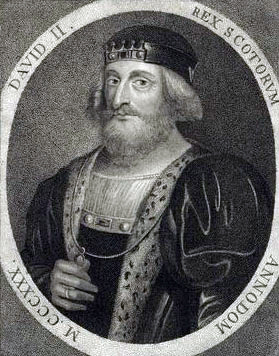by Susan Flantzer © Unofficial Royalty 2015

David II, King of Scots; Credit – Wikipedia
The second and last monarch of the House of Bruce, David II, King of Scots is one of the longest-reigning monarchs of Scotland, having reigned for 41 years, 260 days. He became king in 1329 at the age of five and reigned until he died in 1371 at the age of 46. Born on March 4, 1324, at Dunfermline Palace in Fife, Scotland, David was the elder, but only surviving son of Robert I, King of Scots (also known as Robert the Bruce) and his second wife Elizabeth de Brugh.
David had a twin brother and two sisters:
- Margaret (died 1346/47), married William de Moravia, 5th Earl of Sutherland, had one son who died at age 20 of the plague
- Matilda (died 1353), married Thomas Isaac, had two daughters
- John (March 5, 1324 – 1327), younger twin brother of David II
David also had a half-sister Marjorie Bruce (1296 – 1316) from his father’s first marriage to Isabella of Mar. Marjorie married Walter Stewart, 6th High Steward of Scotland. Like her mother Isabella of Mar, Marjorie also died in childbirth at age 19. She was thrown from her horse, went into premature labor, and died soon after delivering a son. Her son became Robert II, King of Scots, the first monarch of the Stewart dynasty. Marjorie’s descendants include the House of Stewart and all their successors on the thrones of Scotland, Great Britain, and the United Kingdom.
On July 17, 1328, four-year-old David married seven-year-old Joan of the Tower, the youngest daughter of King Edward II of England and Isabella of France. David’s mother had died in 1327 and upon the death of his father on June 7, 1329, David succeeded to the Scottish throne. The child king and queen were crowned and anointed at Scone Abbey on November 24, 1331.

Joan and David II with Philip VI of France; Credit – Wikipedia
In 1332-1333, David’s brother-in-law King Edward III of England invaded Scotland in support of Edward Balliol‘s claim to the Scots throne and defeated the Scots. David and Joan sought refuge in France and remained there from 1334 until May 1341 when David returned to Scotland and took control of the government. King Philip VI of France persuaded David to invade England. However, the Scots forces were defeated at the Battle of Neville’s Cross on October 17, 1346, and David was taken prisoner and held by the English for eleven years. He was finally freed in 1357 by the Treaty of Berwick which stipulated that a large ransom would be paid over the next 10 years.

David II (left) and Edward III (right); Credit – Wikipedia
Joan, who had accompanied her husband in his exiles, died on September 7, 1362, at the age of 41, without giving her husband an heir. David married his mistress Margaret Drummond on February 20, 1364. He divorced her in 1370 on the grounds of infertility. However, Margaret successfully petitioned Pope Urban V to reverse the divorce because it seemed likely that David was infertile as his 34-year marriage to his first wife produced no issue.
In the later years of his reign, David continued pursuing peace with England and worked to make Scotland a stronger kingdom with a more prosperous economy. David II, King of Scots, aged 46, died unexpectedly on February 22, 1371, at Edinburgh Castle and was buried at Holyrood Abbey in Edinburgh, now in ruins. As both his marriages were childless, David was succeeded by his nephew, the son of his half-sister Marjorie, who became Robert II, King of Scots, the first monarch of the House of Stewart.

Ruins of Holyrood Abbey; Photo Credit – Wikipedia
This article is the intellectual property of Unofficial Royalty and is NOT TO BE COPIED, EDITED, OR POSTED IN ANY FORM ON ANOTHER WEBSITE under any circumstances. It is permissible to use a link that directs to Unofficial Royalty.
